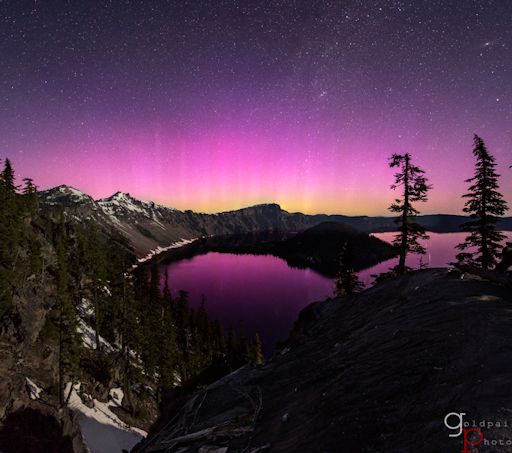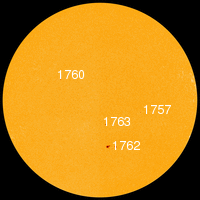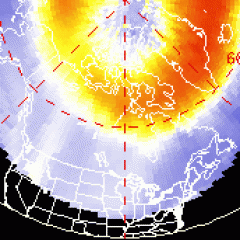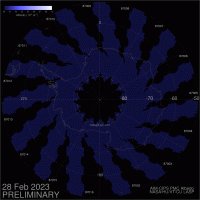~ Space Weather Update~ Chance of Storms, Solar Wind Remains Above 700, Amazing [1]
CHANCE OF STORMS: NOAA forecasters estimate a 50% chance of polar geomagnetic storms on June 2nd as a high-speed (700 km/s) solar wind stream buffets Earth's magnetic field. The warning comes on the heels of a lengthy G2-class [2] geomagnetic storm on May 31-June 1 sparked by the arrival of an interplanetary shock wave. The source of the shock is unknown. Current speculation focuses on a corotating interaction region (CIR)--that is, a shock-like transition zone between high- and low-speed solar wind streams. Whatever it was, the impact ignited some beautiful auroras [3], described below. Aurora alerts: text [4], voice [5].
AURORAS IN THE USA: On June 1st, Northern Lights spilled across the Canadian border into more than a dozen US states, turning the sky purple and green as far south as Colorado [6] and Nebraska [7]. Subscribers to the Space Weather Alert System (text [4], voice [5]) knew the storm was coming, but others were surprised:
"Last night, I drove to Crater Lake National Park to photograph the Milky Way rising above the rim," reports Oregon photographer Brad Goldpaint. "I was staring upward towards a clear night sky when suddenly, without much warning, the aurora borealis began erupting in front of me." (continued below)
"With adrenaline pumping, I raced to the edge of the caldera, set up a time-lapse sequence, and watched northern lights dance until sunrise," he continues. "The moon rose around 2am and blanketed the surrounding landscape with a faint glow, adding depth and texture to the shot."
High-latitude sky watchers should remain alert for auroras tonight as Earth's magnetic field continues to reverberate from the impact. NOAA forecasters estimate a 40% chance of polar geomagnetic storms on June 1st. Aurora alerts: text [4], voice [5].

![]()
Solar wind
speed: 743.4 km/sec
density: 1.4 protons/cm3
explanation [9] | more data [10]
Updated: Today at 1647 UT
![]()
X-ray Solar Flares
6-hr max: B7 1027 UT Jun02
24-hr: C1 0521 UT Jun02
explanation [11] | more data [12]
Updated: Today at: 1600 UT
![]()
![]()
![]()
Daily Sun: 02 Jun 13
![]()
![]()
None of these magnetically-simple sunspots poses a threat for strong solar flares. Credit: SDO/HMI
![]()
![]()
![]()
Sunspot number: 60
What is the sunspot number? [14]
Updated 01 Jun 2013
Spotless Days
Current Stretch: 0 days
2013 total: 0 days (0%)
2012 total: 0 days (0%)
2011 total: 2 days (<1%)
2010 total: 51 days (14%)
2009 total: 260 days (71%)
Since 2004: 821 days
Typical Solar Min: 486 days
Update 01 Jun 2013
The Radio Sun
10.7 cm flux: 104 sfu
explanation [15] | more data [16]
Updated 31 May 2013
![]()
![]()
![]()
Current Auroral Oval:
![]()
![]()
Switch to: Europe, USA, New Zealand, Antarctica
Credit: NOAA/POES
![]()
![]()
![]()
Planetary K-index
Now: Kp= 3 quiet
24-hr max: Kp= 5 storm
explanation [18] | more data [19]
![]()
Interplanetary Mag. Field
Btotal: 4.4 nT
Bz: 1.1 nT north
explanation [20] | more data [21]
Updated: Today at 1647 UT
![]()
![]()
![]()
Coronal Holes: 01 Jun 13
![]()
![]()
Solar wind flowing from this coronal hole should hit Earth's magnetic field on June 3-4. Credit: SDO/AIA.
![]()
![]()
NEW: Spaceweather.com is now posting daily satellite images of noctilucent clouds (NLCs), which hover over Earth's poles at the edge of space. The data come from NASA's AIM [23] spacecraft. The north polar "daisy" pictured below is a composite of near-realtime images from AIM assembled by researchers at the University of Colorado's Laboratory for Atmospheric and Space Physics (LASP).
![]() Noctilucent Clouds
Noctilucent Clouds
![]()
![]()
![]()
Switch view: Europe, USA, Asia, Polar
![]()
Updated at: 06-01-2013 10:55:03




